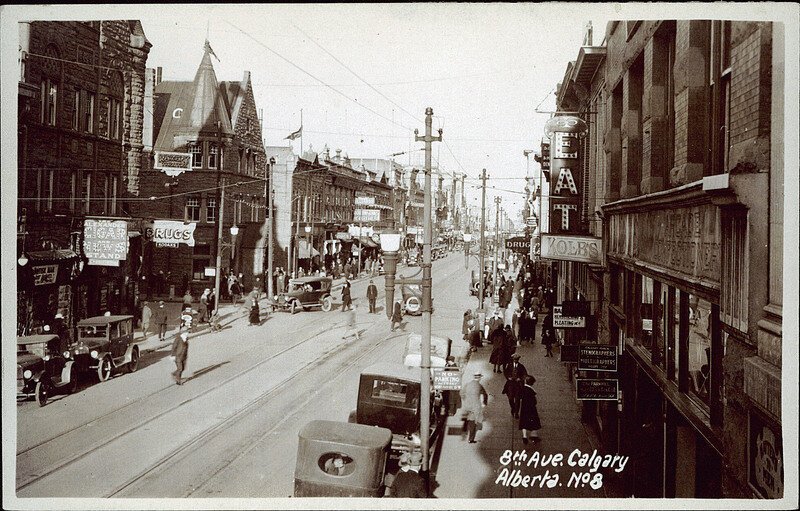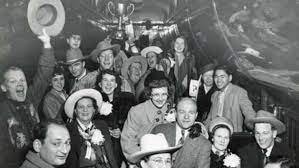The Mayors I've Served
/The following is a memoire written in 1980/81 by Carl B. Cummer who, in a 38-year career rose through the ranks of the civic administration to become the City Clerk — the chief administrator of Calgary’s municipal government.
Calgary ca 1925 when Carl began working for the city
To do a proper job of what I am attempting to do here, that is, to outline what the set-up is for the Mayor on down, would take a considerable amount of research. Consequently, those who for some reason or another happen to read this, please keep in mind that it is by no means a thorough job and is only compiled from memory and any opinions expressed are my own and not necessarily authentic.
MAYOR
When I started with the City, George Webster [[1923-1926]] was Mayor. As a junior in the service I didn’t have much of an opportunity to form an opinion of how he rated as the chief magistrate. I do recall that he and my boss, City Clerk Miller got along well. I believe he was a contractor.
1927 Mayor Osborne greets hrh the prince of wales and british prime minister stanley baldwin.
He was followed by Mayor Fred E. Osborne [[1927-1929]], a business man who was the owner of Osborne’s Book Store and was well respected and liked by everyone who knew him. He was the type of man who never failed to compliment an employee when he saw a job well done and on that account was popular with the employees.
Then came Andrew Davison [[1929-1945]]. (Not “Davidson.” He used to get annoyed about people spelling his name wrong.) Andy Davison was a popular Mayor. He had a tough job during the fifteen or sixteen years he served continuously as Mayor. A good many of those years covered the period of the depression when expenditures had to be pared to the bone. While the City strove to meet interest payments on outstanding debenture issues, it was also necessary to put aside into a Sinking Fund an annual amount sufficient to meet the capital payment when the debentures came due. Towards the latter part of the 1930s due to so many taxpayers being in arrears, and the necessity to use the funds available for the every day requirements necessary to keep the City functioning, the City was on the verge of bankruptcy. Debentures coming due within the immediate future were called in and re-issued for an extended term.
Each debenture in those days required the personal signature of the Mayor and the City Clerk. Both had immaculate signatures. Due to the large amount involved we had to go to the bank and, in an inaccessible office there, validated the thousands of debentures required. It took hours. I was impressed by the way those two could sign their names so many thousand times, without variation and without getting writers cramp. My job was to stick on the gold seals and affix the City seal. My arm was plenty tired when the job was done, just pumping the seal.
[[Editor’s note: one of the major achievements of the Davison administration was the construction of the Glenmore dam, completed in 1933, which continues to supply Calgarians with drinking water. The financing of this massive public works project was aided by the financial acumen of former-mayor Osborne in partnership with Davison.]]
The story of Andy Davison in itself would make most interesting reading. He had been a linotype operator with the Calgary Herald newspaper prior to running for office and first ran under the labor banner. Later he was supported by the Civic Government Association, a group of businessmen who for many years sponsored candidates for civic election.
James C. Watson followed next in line as our Mayor [[1946-1949]]. Jim was a labor man and worked for the Alberta Government Telephones. He was an easy-going individual and Council meetings frequently got out of hand on account of his failure to strictly adhere to the rules of procedure.
Mayor Donald H. MacKay came next [[1950-1959]]. Don was a well known sports announcer and broadcasted over radio station CJCJ. He was well known in that capacity and a most popular figure. Being a Mormon, he neither touched liquor nor smoked. He was tops when it came to making impromptu speeches and no matter what the occasion seemed to have the knack of saying all the right things at the right time. He was a marvelous host and his home was the scene of many gatherings of friends from all walks of life.
1951 Mayor don mackay with hrh the duke of edinburgh.
He was a great Calgary booster and I doubt if anyone ever took a greater part in publicizing the City than he did. In 1948, as an Alderman, it was Don MacKay who helped organize a cross-Canada travelling hoopla that has become legendary in Calgary lore and the most talked-about event in Canadian football history for many years. The Calgary Stampeders won the 1948 Western Conference, but the Grey Cup playoff was always held in the East. Toronto was the scene of the finals in that particular year. Calgary had gained a reputation as something of a cow-town and Don had already popularized the white stetson as a symbol of our image. White hats were presented to visiting dignitaries as part of Calgary’s hospitality. A special train was arranged to take football fans to Toronto for the Canadian championship. The train, loaded to the gills with whooping, hollering fans, baggage cars filled with chuck wagons, horses, saddles, white hats and what-not started for the East. At stops along the way, everyone got out, staged square dances on the station platform and generally whooped it up.
On their arrival in Toronto, the Calgarians took the city by storm. Never before had Torontonians seen such shenanigans over a football game. Hotel lobbies were taken over for square dances. Chuck wagons swung into action at several downtown street corners and served flapjacks and bacon to the crowds that milled around. Synthetic cowboys, under white stetsons were everywhere to be seen. At first, staid Torontonians were taken aback at such a display of enthusiasm, but soon livened up and fell right in with the celebrants.
With Calgary winning the Grey Cup in the dying minutes of the game, from then on nothing short of bedlam could aptly describe the elation of the Calgary crowd. By this time all Canada had heard through the media about the goings-on and if the trip East was considered such a great event, it was by far surpassed by the trip back to Calgary. At practically every town along the way crowds met at the station and where no stop was scheduled, just to wave as the train passed by. When the train stopped for sufficient time to permit it, there was a repetition of the square dancing on station platforms or inside the station with the same degree of exuberance as that displayed on the way down, as far as the participants’ strength and energy would permit. But it must be noted here that many of them had not had more than a few hours sleep from the time they left Calgary until their return.
As an indication of Toronto’s good sportsmanship, the following year they organized a group of their businessmen to reciprocate in their way by visiting Calgary and participating in the Calgary Stampede Parade dressed in formal business attire, top hat and tails, depicting the Bay Street image Westerners were purported to have of the East. They did their share of cutting-up along the parade route as well. Every since that eventful trip to the Grey Cup attempts have been made by other Western team winners to emulate Calgary’s efforts, but never have any succeed in surpassing that eventful episode.
When Don ran for mayor the following year, he was elected with a good majority.
Mayor Harry Hays [[1959-63]] took over the office of Mayor at the election held in 1959 and was still in office when I retired in 1963. He was a cattleman and an auctioneer. You always knew where you stood with Harry. He was an outspoken individual and never pulled any punches. One of the things I admired in him was that when he had an idea about how some of the things around City Hall might be changed to run more efficiently, he would talk it over with the head of the department concerned and listen to advice.
Carl B. Cummer
[[Editors note: This is a transcription of a personal memoire of Carl B. Cummer (1903-1989) left to the editor along with other papers of Cummer family history. Carl began working for the City in 1925 as a stenographer and retired in 1963 as City Clerk. It is the editor’s intention to transcribe more of Uncle Carl’s memoires in future blogs.]]
The Calgary skyline had changed by 1963 when Carl retired from city hall.



















